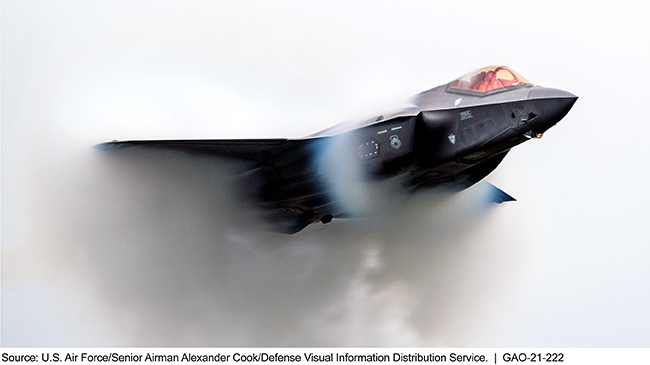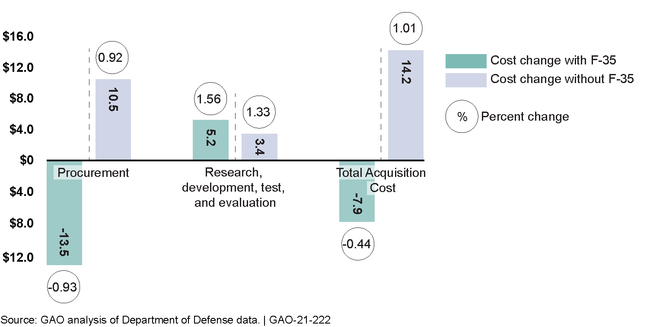Weapon Systems Annual Assessment: Updated Program Oversight Approach Needed
Fast Facts
Our 19th annual assessment of DOD's weapon programs looks at changes to how DOD acquires weapon systems.
DOD now has 6 acquisition "pathways" that aim to account for varying factors like the type of system and how quickly it's needed. Program managers can tailor their approach, for example, by using multiple pathways to develop a system that provides the warfighter what they need, when they need it.
But DOD's plan for overseeing weapon systems doesn't include all pathway options.
We recommended DOD update its oversight approach.
DOD weapon system acquisition is on our High Risk List.
F-35A Lightning II Fighter Jet Performs Aerial Maneuvers

Highlights

GAO's 19th annual assessment of the Department of Defense's (DOD) weapon programs comes at a time of significant internal changes to the department's acquisition process. Specifically, DOD began implementing its new acquisition framework intended to, among other things, deliver solutions to the end user in a timely manner. However, GAO found that many programs have planned acquisition approaches that, unless properly managed and overseen, could result in cost and schedule challenges similar to those GAO has reported on for nearly the past 2 decades.
DOD's new acquisition framework allows program managers to use one or more of six acquisition pathways—including the major capability acquisition and middle-tier acquisition (MTA) pathways used by the programs GAO reviewed. Each pathway is governed by separate policies for milestones, cost and schedule goals, and reporting. Program managers can tailor, combine, and transition between pathways based on program goals and risks associated with the weapon system being acquired (see figure).
Notional Use of Multiple Efforts and Multiple Pathways

DOD's framework also introduces new considerations to program oversight. In particular, DOD has yet to develop an overarching data collection and reporting strategy for programs transitioning between acquisition pathways or conducting multiple efforts using the same pathway to deliver the intended capability. The lack of a strategy not only limits DOD's visibility into these programs but also hinders the quality of its congressional reporting and makes the full cost and schedule of the eventual weapon system more difficult to ascertain.
DOD Plans to Invest Over $1.79 Trillion in Its Costliest Weapon Programs, but Not All Costs Are Reported
DOD's reported costs primarily reflect major defense acquisition program (MDAP) investments (see table). However, DOD is increasingly using the MTA pathway to acquire weapon programs . The totals do not include all expected costs because, among other things, MTA estimates do not reflect any potential investments after the current MTA effort, and cost figures do not include programs that have yet to formally select a pathway or are classified or sensitive.
Department of Defense Total Investments in Selected Weapon Programs GAO Reviewed (fiscal year 2021 dollars in billions)

Procurement reductions in DOD's costliest program—the F-35—drove an MDAP portfolio cost decrease since GAO's last annual report (see figure). Excluding this program, quantity changes and other factors such as schedule delays contributed to one-year portfolio cost growth. Sixteen MDAPs also showed schedule delays since GAO's 2020 report. Such delays are due, in part, to delivery or test delays and poor system performance.
Major Defense Acquisition Program One-Year Cost Change Including and Excluding the F-35 Program (fiscal year 2021 dollars in billions)


F-35 reported an overall procurement cost decrease of $23.9 billion in fiscal year 2020, primarily due to lower prime and subcontractor labor rates.
As GAO found last year, DOD continues to expand its portfolio of the costliest MTA programs, expecting to spend $30.5 billion on current efforts. Due to inconsistent cost reporting by MTA programs, GAO could not assess cost trends across the MTA portfolio. However, GAO observed examples of cost changes on certain MTA programs compared with last year.
Weapon Programs Do Not Consistently Plan to Attain Knowledge That Could Limit Cost Growth and Deliver Weapon Systems Faster
Most MDAPs continue to forgo opportunities to improve cost and schedule outcomes by not adhering to leading practices for weapon system acquisitions. Some MTA programs also reported planning to acquire only limited product knowledge during program execution, leading to added risks to planned follow-on efforts.
Further, while both MDAPs and MTA programs increasingly reported using modern software approaches and cybersecurity measures, they inconsistently implemented leading practices, such as frequently delivering software to users and conducting certain types of cybersecurity assessments during development.
Why GAO Did This Study
Title 10, section 2229b of the U.S. Code contains a provision for GAO to review DOD's weapon programs. This report assesses the following aspects of DOD's costliest weapon programs: their characteristics and performance, planned or actual implementation of knowledge-based acquisition practices, and implementation of selected software and cybersecurity practices. The report also assesses oversight implications of DOD's changes to its foundational acquisition guidance.
GAO identified programs for review based on cost and acquisition status; reviewed relevant legislation, policy, guidance, and DOD reports; collected program office data; and interviewed DOD officials .
Recommendations
GAO recommends DOD develop a reporting strategy to improve oversight of those weapon systems developed using multiple efforts or pathways. DOD concurred with our recommendation.
Recommendations for Executive Action
| Agency Affected | Recommendation | Status |
|---|---|---|
| Department of Defense | The Secretary of Defense should direct the Office of the Under Secretary of Defense for Acquisition and Sustainment to ensure that internal and external reporting for capabilities developed using multiple efforts or pathways provides information on each individual effort, as well as the overall planned cost and schedule required to deliver the eventual capability. (Recommendation 1) |
DOD concurred with the recommendation. In July 2022, the Under Secretary of Defense for Acquisition and Sustainment (USD (A&S)) updated its guidance to require programs to report on the total cost of the capability for programs using multiple efforts or pathways. However, the guidance did not address how DOD will report on overall planned schedule required to deliver the eventual capability, as we recommended. In November 2023, the USD(A&S) issued modernized reporting guidance for the Major Capability Acquisition pathway that requires programs to report descriptions of interdependent programs, including milestones and decision points. However, DOD has yet to issue similar schedule reporting guidance for programs using the Middle Tier of Acquisition or other pathways. An official from the USD(A&S) provided an update in October 2024, stating the Department plans to update its acquisition policies for multiple pathways on the Adaptive Acquisition Framework. Until these efforts are fully implemented, we will continue to track DOD's progress in this area.
|
